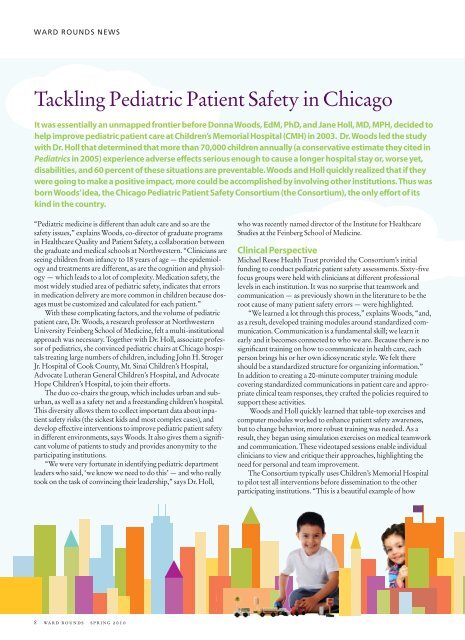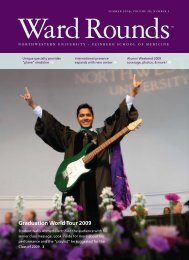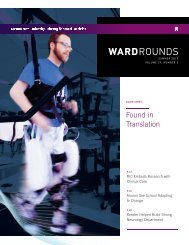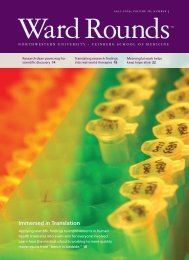Download PDF - Ward Rounds - Northwestern University
Download PDF - Ward Rounds - Northwestern University
Download PDF - Ward Rounds - Northwestern University
You also want an ePaper? Increase the reach of your titles
YUMPU automatically turns print PDFs into web optimized ePapers that Google loves.
<strong>Ward</strong> RounDS nEWS<br />
Tackling Pediatric Patient Safety in Chicago<br />
It was essentially an unmapped frontier before Donna Woods, EdM, PhD, and Jane Holl, MD, MPH, decided to<br />
help improve pediatric patient care at Children’s Memorial Hospital (CMH) in 2003. Dr. Woods led the study<br />
with Dr. Holl that determined that more than 70,000 children annually (a conservative estimate they cited in<br />
Pediatrics in 2005) experience adverse effects serious enough to cause a longer hospital stay or, worse yet,<br />
disabilities, and 60 percent of these situations are preventable. Woods and Holl quickly realized that if they<br />
were going to make a positive impact, more could be accomplished by involving other institutions. Thus was<br />
born Woods’ idea, the Chicago Pediatric Patient Safety Consortium (the Consortium), the only effort of its<br />
kind in the country.<br />
“Pediatric medicine is different than adult care and so are the<br />
safety issues,” explains Woods, co-director of graduate programs<br />
in Healthcare Quality and Patient Safety, a collaboration between<br />
the graduate and medical schools at <strong>Northwestern</strong>. “Clinicians are<br />
seeing children from infancy to 18 years of age — the epidemiology<br />
and treatments are different, as are the cognition and physiology<br />
— which leads to a lot of complexity. Medication safety, the<br />
most widely studied area of pediatric safety, indicates that errors<br />
in medication delivery are more common in children because dosages<br />
must be customized and calculated for each patient.”<br />
With these complicating factors, and the volume of pediatric<br />
patient care, Dr. Woods, a research professor at <strong>Northwestern</strong><br />
<strong>University</strong> Feinberg School of Medicine, felt a multi-institutional<br />
approach was necessary. Together with Dr. Holl, associate professor<br />
of pediatrics, she convinced pediatric chairs at Chicago hospitals<br />
treating large numbers of children, including John H. Stroger<br />
Jr. Hospital of Cook County, Mt. Sinai Children’s Hospital,<br />
Advocate Lutheran General Children’s Hospital, and Advocate<br />
Hope Children’s Hospital, to join their efforts.<br />
The duo co-chairs the group, which includes urban and suburban,<br />
as well as a safety net and a freestanding children’s hospital.<br />
This diversity allows them to collect important data about inpatient<br />
safety risks (the sickest kids and most complex cases), and<br />
develop effective interventions to improve pediatric patient safety<br />
in different environments, says Woods. It also gives them a significant<br />
volume of patients to study and provides anonymity to the<br />
participating institutions.<br />
“We were very fortunate in identifying pediatric department<br />
leaders who said, ‘we know we need to do this’ — and who really<br />
took on the task of convincing their leadership,” says Dr. Holl,<br />
who was recently named director of the Institute for Healthcare<br />
Studies at the Feinberg School of Medicine.<br />
Clinical Perspective<br />
Michael Reese Health Trust provided the Consortium’s initial<br />
funding to conduct pediatric patient safety assessments. Sixty-five<br />
focus groups were held with clinicians at different professional<br />
levels in each institution. It was no surprise that teamwork and<br />
communication — as previously shown in the literature to be the<br />
root cause of many patient safety errors — were highlighted.<br />
“We learned a lot through this process,” explains Woods, “and,<br />
as a result, developed training modules around standardized communication.<br />
Communication is a fundamental skill; we learn it<br />
early and it becomes connected to who we are. Because there is no<br />
significant training on how to communicate in health care, each<br />
person brings his or her own idiosyncratic style. We felt there<br />
should be a standardized structure for organizing information.”<br />
In addition to creating a 20-minute computer training module<br />
covering standardized communications in patient care and appropriate<br />
clinical team responses, they crafted the policies required to<br />
support these activities.<br />
Woods and Holl quickly learned that table-top exercises and<br />
computer modules worked to enhance patient safety awareness,<br />
but to change behavior, more robust training was needed. As a<br />
result, they began using simulation exercises on medical teamwork<br />
and communication. These videotaped sessions enable individual<br />
clinicians to view and critique their approaches, highlighting the<br />
need for personal and team improvement.<br />
The Consortium typically uses Children’s Memorial Hospital<br />
to pilot test all interventions before dissemination to the other<br />
participating institutions. “This is a beautiful example of how<br />
8 ward rounds summer spring 2010












